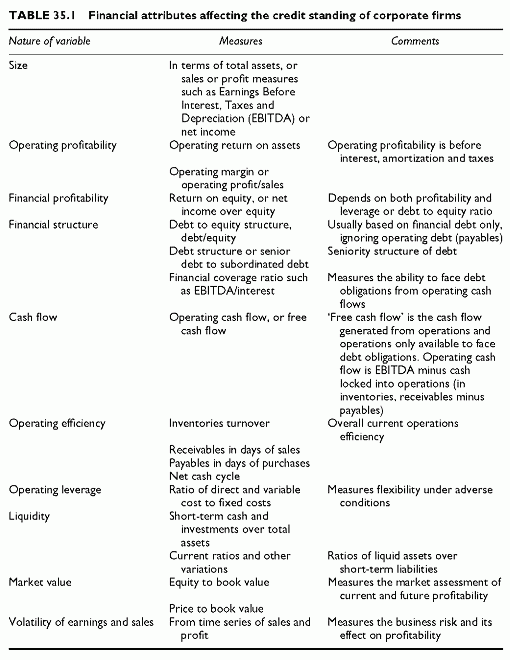RATING CRITERIA
Category: Risk Management in Banking
Rating criteria include both qualitative assessment of the counterpartys credit standing plus quantitative variables, most of them being financial variables. Rating a corporate entity will always involve qualitative and judgmental components, simply because there are too many factors that influence the situation of a corporate and of a financial entity. What follows cannot be comprehensive, but provides an overview of the nature of rating criteria.
The basis for assessing the credit risk of a company does relates to its fundamentals. These include all strengths, weaknesses, opportunities and threats (SWOT) plus any barriers to entry that provide a shield from competition. Among major factors driving corporate firms health are: industry, possibly oligopolistic, with few competitors; market share and size; diversification of products and services, and across countries; growth potential; technology; quality of products and services; plus all barriers to entry. Other factors include management quality and record of accomplishment. Some of these factors relate to the firms future potential as well as to risk. Typical risk factors are business risk, possibly measured with the cyclical dynamics of sales or simply the economics of the industry, some of them being more stable across time than others (capital-intensive industries, consumer durable), or the level of vertical integration which drives the ratio of fixed to variable costs.
Criteria differ depending on the type of counterparty. For financial institutions, some ratios have a specific importance, such as the capital to assets ratio or the ratio of loan loss reserves to total loans. In addition, the relevance of banking information depends on the regulators requirements. If these impose stringent constraints on local banks, chances are that the banks information is reliable. If regulation practices are sound, the intrinsic quality of the bank is a major factor. Otherwise, the supervisory system drives the ratings because the information from financial institutions becomes unreliable. It is preferable to look first at the banking industry as a whole and then at country risk.
We provide below a grid of financial criteria applicable to corporate borrowers. This grid ignores such important qualitative variables as management quality or support, because we focus in this sample grid on financial attributes that can serve as inputs in rating models. Evidently, however, such qualitative variables as market outlook, management
track record, or industry would nicely complement this grid limited to quantitative variables. Note also that all variables refer to corporate borrowers. A different list of financial ratios would be more relevant for banks.
Quantitative variables are mainly financial, although other observable attributes might also convey relevant information. Under a normative view, a grid of financials applying to a corporate borrower could be as in Table 35.1. Note that the models relating observable attributes to ratings do not effectively use all of them. In addition, empirical findings show that some variables discriminate effectively credit standing in some broad classes of firms and not in others. Such broad classes are defined by ratings, i.e. investment grade versus speculative grade, or size bands, i.e. very large firms versus middle sized or small firms. Empirical findings using the techniques of Chapter 37 are that credit standing is sensitive to operating profitability, measured as Return On Assets (ROA), size and financial leverage (debt to equity ratio), and market to book value, when available, which presumably captures the efficiency of capital markets in assessing the strengths and weaknesses of firms. Note also that many of these variables are correlated, i.e. that highly profitable firms have relative leverage and so on.

